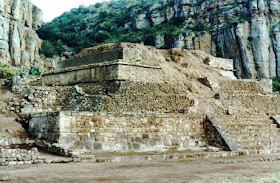 Mystery Pyramid Built by Newfound Ancient Culture?
Alexis Okeowo in México City
Mystery Pyramid Built by Newfound Ancient Culture?
Alexis Okeowo in México City
for National Geographic News (Photo: National Geographic website)
December 8, 2008
Several stone sculptures recently found in central Mexico point to a previously unknown culture that likely built a mysterious pyramid in the region, archaeologists say.
Archaeologists first found the objects about 15 years ago in the valley of Tulancingo, a major canyon that drops off into Mexico's Gulf Coast.
Most of the 41 artifacts "do not fit into any of the known cultures of the Valley of Tulancingo, or the highlands of central Mexico," said Carlos Hernández, an archaeologist at Mexico's National Institute of Anthropology and History in the central state of Hidalgo.
Many of the figures are depicted in a sitting position, with their hands placed on their knees. Some have headdresses or conical hats with snakes at the base, which could represent Ehécatl-Quetzalcóatl, the Aztec god of the wind. One figure shows a man emerging from the jaws of a jaguar. The sculptures are also made of flat stucco—a combination of fine sand, lime, and water—and painted blue or green to the give the appearance of jade.
All of the artifacts date to the Epiclassic period between A.D. 600 to 900.
Some Mexican and foreign archaeologists have said the sculptures weren't ancient and thus false, Hernández said.
"But by linking all the characteristics that make them different, [such as their location in Tulancingo and time period], allows us to say that they should be considered as a product of a different culture [called Huajomulco]."
The culture is named after an area in Hidalgo.
Baffling Pyramid
Some of the artifacts were also found near the mysterious Huapalcalco pyramid in Hidalgo, whose origin has been a source of debate among archaeologists.
The pyramid's proportions, along with smaller structures that were painted black and white, do not correspond to the Toltec or Teotihuacan cultures of the same area and time period.
The Teotihuacan people, who lived from 400 B.C. to A.D. 700, constructed one of the largest pyramid complexes in the pre-Hispanic Americas, which refers to cultures that lived on the continent before the Spanish conquest of the Western Hemipshere.
The Toltecs, who came afterward, were made up of several groups of South Americans that together formed an empire famous for its artists and builders in the Teotihuacan capital of Tula from A.D. 900 until the 1100s.
The pottery found at the site—rough, cylindrical vessels that are gray and reddish-brown in color—is also not familiar to experts.
Based on the artifacts' discovery near the pyramid, "it is likely that the Huapalcalco pyramid has been built by people from this new culture," Hernández said.
Thomas Charlton, an archaeologist at University of Iowa, has worked in the state of Hidalgo. He said that ample evidence—including the new artifacts—links a new pre-Hispanic culture to the Huapalcalco pyramid.
"It's a reasonable hypothesis [that] near the Valley of Tulancingo, there is a site that looks like it existed between the fall of the Teotihuacan and the beginning of the Tula [Toltec]," Charlton added.
"We know that there's an occupation [from this time] near Tulancingo.
"After the Teotihuacan, there were all sorts of smaller states throughout Mexico. It's part of the cycle after the fall of an empire."
Creative Era
Michael Smith, an archaeologist at Arizona State University, agreed.
"The notion that there would be an independent culture in [the Epiclassic] period is not surprising at all," he said.
"It was a very creative period, with rich development."
Future excavations of Huapalcalco should solidify the link to a new pre-Hispanic culture, and help archaeologists glean clues about this lost time, Hernández said.
"The [Epiclassic] period is considered a time of dynamic development—new trade, cities, and development," said Arizona State's Smith, "but one we don't know much about."
No comments:
Post a Comment